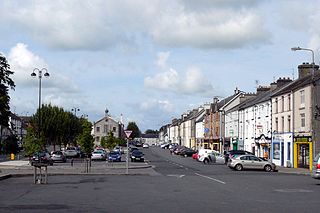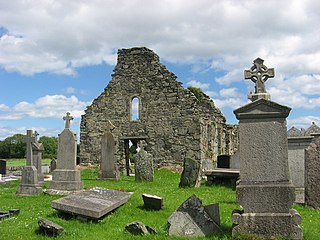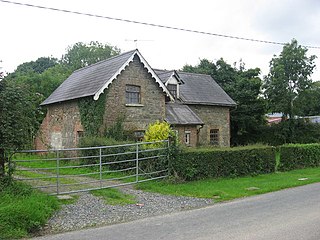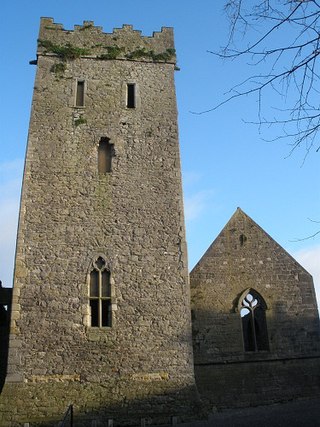
Templemore is a town in County Tipperary, Ireland. It is a civil parish in the historical barony of Eliogarty. It is part of the parish of Templemore, Clonmore and Killea in the Roman Catholic Archdiocese of Cashel and Emly.

Ardee is a town and townland in County Louth, Ireland. It is located at the intersection of the N2, N52, and N33 roads. The town shows evidence of development from the thirteenth century onward but as a result of the continued development of the town since then much of the fabric of the medieval town has been removed.
County Louth, otherwise known as Louth County or Louth, is a former parliamentary constituency in Ireland, which was represented in the House of Commons of the Parliament of the United Kingdom. From 1801 to 1885 it returned two Members of Parliament (MPs), and one from 1918 to 1922.
Ardee was a constituency represented in the Irish House of Commons from 1378 to 1801.

Tullyallen is a village, civil parish and townland 6 km north-west of the town of Drogheda in County Louth, Ireland. It is in the historic Barony of Ferrard. It is located in the historical Boyne Valley, in the Catholic parish of Mellifont ; it is also close to Newgrange, Knowth and Dowth burial mounds, Monasterboice monastery, and to the Battle of the Boyne site.

Togher is a large parish in County Louth, Ireland. A rural parish in the Roman Catholic Archdiocese of Armagh, Togher is situated approximately halfway between Drogheda and Dundalk.

Drumconrath or Drumcondra is a small village in north County Meath, Ireland. The parish borders County Louth and is also close to the borders of Counties Monaghan and Cavan. As of the 2016 census, the village had a population of 345 people.
Sir William Bellingham, 1st Baronet was an Irish-born British politician and the Controller of Storekeepers Accounts for the Royal Navy. Bellingham was charged with organizing and procuring provisions for the Vancouver Expedition. Though he never saw the Pacific Ocean, Bellingham Bay and the city of Bellingham, Washington, are named for him.
County Louth was a constituency represented in the Irish House of Commons to 1801.

Cullyleenan is a townland in the Parish of Tomregan, Barony of Tullyhaw, County Cavan, Ireland.
The High Sheriff of Louth was the Crown's representative for County Louth, a territory known as his bailiwick. Selected from three nominated people, he held his office for the duration of a year. He had judicial, ceremonial and administrative functions and executed High Court Writs.

Drumcar is a village and a historical parish, in the barony of Ardee, County Louth, Leinster, northeastern Ireland.
Richard White was an Irish judge who held office as Lord Chief Justice of Ireland; he is remembered mainly for his complaints to the English Crown about the corruption and inefficiency of his judicial colleagues.

St. Mary's Church is a medieval church and National Monument in Callan, Ireland.

Roodstown Castle is a 15th-century tower house and National Monument located in County Louth, Ireland.

Greenmount Motte is a motte and National Monument in County Louth, Ireland.

The Priory of St. Mary in Cahir, known as Cahir Abbey, was a medieval priory of Augustinian Canons regular and is a National Monument located in Cahir, Ireland.

Kilmacrenan, sometimes spelled Kilmacrennan, is a barony in County Donegal, Ireland. Baronies were mainly cadastral rather than administrative units, which acquired modest local taxation and spending functions in the 19th century before being superseded by higher units under the Local Government (Ireland) Act 1898. Kilmacrenan is the largest barony in Ireland by land area.
Killincoole is a civil parish in County Louth Ireland. It consists of three townlands:













